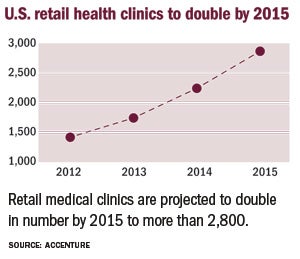Will retail medical clinics return to 'save the day'?

Times have changed. Once viewed as a potential threat to hospitals and primary care physicians (PCPs), retail medical clinics now are viewed often as an ally.
Why? New research says that the expected growth in retail medical clinics has the potential to serve as a low-cost and convenient option that will ease an overburdened health care system and cut costs by hundreds of millions.
The number of retail medical clinics is projected to double over the next three years as health care reform takes hold and causes an anticipated surge in the number of insured patients.
Clinics are expected to grow 25 to 30 percent annually over the next three years from an estimated 1,400 now to more than 2,800 by 2015, according to new research from global management consulting firm Accenture.
The rapid growth in clinics will occur in response to millions of Americans becoming insured under the Affordable Care Act. The growth may help to ease the burden on hospitals already operating at capacity and save up to $800 million annually in overall health care expenditures, Accenture reports.
"Now, with more than 30 million potential patients entering the market, hospitals will feel pressure to keep pace. Retail clinics may be able to act as a 'release valve' to the strained health care system, leading to clinics' expansion," says Alan Nalle, manager of global payer strategy for Accenture's health business.
The growth may benefit other stakeholders such as PCPs and third-party payers. Retail clinics will give PCPs referral options for patients with less serious health issues, which clinics typically treat. Payers stand to gain from lower-cost health care services and already are creating links to retail clinics, says the report. Accenture predicts that retail clinics eventually will fulfill 10.8 million visits per year.




